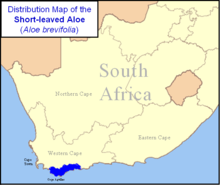|
Aloe brevifolia
Aloe brevifolia, the short-leaved aloe, is a species of flowering plant in the family Asphodelaceae. It is a tiny, compact, blue-green evergreen succulent perennial, that is native to the Western Cape, South Africa. Listed as Endangered on SANBI's Red List, it is threatened in its natural habitat, but is also widely popular as an ornamental plant in rockeries and desert gardens worldwide.[2] DistributionIn the wild, this diminutive species is completely confined to the dry clay soil of “Rûens Shale Renosterveld” – a critically endangered and rapidly disappearing vegetation type. Small populations are normally found growing on inaccessible rocky slopes and cliffs, especially near the coast, but it is thought that these are merely relics of what was once a much wider distribution. There are several subspecies, which are now separated from each other by farmland and other development.[1] Conservation statusA. brevifolia has been assessed as endangered due to its fragmented and decreasing population in 12 remaining locations. There are less than 2000 mature individuals in the wild; most are isolated and sparsely populated with the biggest subpopulation having 100 to 200 mature individuals. It is also threatened with a decline in Renosterveld and Strandveld habitats from agriculture expansion; 80% of its habitat has been lost to crop cultivation and now has a 52-76 km2 area of occupancy.[1] Appearance Though only 10 cm in height,[3] the Kleinaalwyn tends to sprout suckers from its sides that become new rosettes. Consequently, it can form large clumps. The leaves are short and fat and edged with soft, harmless, white teeth. In fact, the name "brevifolia" means "short-leaf" in Latin.[4] The plant is also distinctive for its gray-blue colour. In November it sends up a (relatively) tall inflorescence with bright red flowers.[5] CultivationThis dwarf aloe is increasingly popular as an ornamental plant for pots and rockeries. In cultivation it should be planted in a reasonably sunny position, in well-drained soil. It requires only moderate watering and should not be kept perpetually damp. It should be remembered that it is adapted to the Mediterranean climate of the Western Cape, with its winter rainfall regime. It can be propagated easily by simply removing and replanting the branching suckers. [6] As it requires winter heat, in temperate regions it is grown under glass or as a houseplant. It has gained the Royal Horticultural Society's Award of Garden Merit.[3] References
External linksWikimedia Commons has media related to Aloe brevifolia.
|
||||||||||||||||||||||||||||||||||


